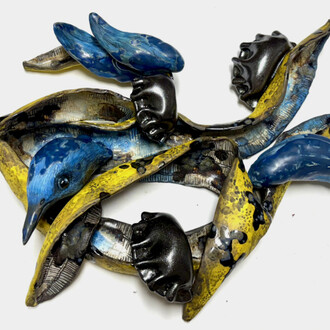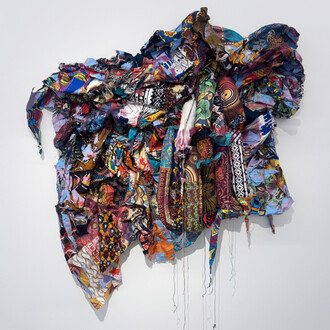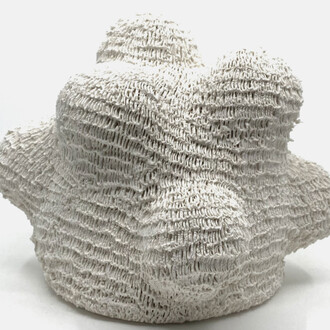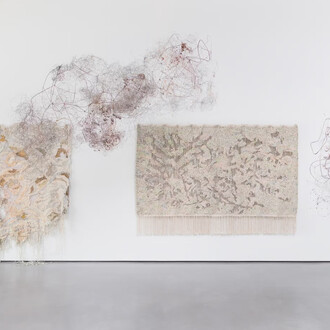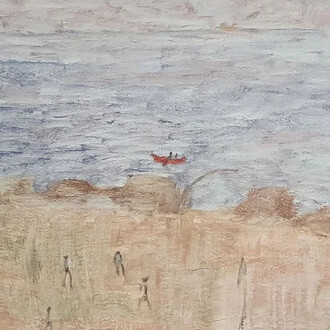Mindy Solomon Gallery is proud to present the works of Danny Ferrell, Hiba Schahbaz, and Sophia Narrett. Embracing an aesthetic stimulated by love, intimacy, and sensuality, each artist combines their own personal narrative within the genre of figurative art.
Danny Ferrell creates warmly filtered images of men and their pets. His work suggests male vulnerability that belies the stereotype of the masculine, insensitive man. Ferrell’s sunrise palette evokes a sense of innocence and spirituality, inspired by the dawn of a new day.
Ferrell writes of his work: I grew up in rural Pennsylvania, in a small town of no more than a few thousand residents. Deeply conservative, most placed religion above all other virtues, and anyone deviating from religious law was treated as a herald of immorality. I was a man whose love for other men violated the cultural norms, forcing me to conceal my personal life from others in the public sphere, often causing severe feelings of guilt and alienation.
My paintings represent fantasies and fears about the ‘Other’ through depictions of the everyday queer male. Working within the tradition of the Cadmus Circle and Hudson River School, I perch the figure on the edge of the quotidian, where lush landscapes, colorful gradients and intricate patterns interact to create a ‘magic reality’ that is both ordinary and extraordinary. A formal and conceptual tension is at play, which is structured by ever-present dichotomies: public/private, nature/culture, taste/ kitsch, transparency/opacity. Loosely based on my own relationships, experiences, and imagination, my work functions like a daydream, where memory and longing shape a personal fiction.
Recently, I have been gesturing to the vast canon of European royalty painting by blending the epic and banal in painted images of gay men and their dogs. This combination quotes the pageantry of that history – their rich garb and over-the-top landscapes – and in so doing, elevates queer bodies from second class, to royal class.
Hiba Schahbaz utilizes impressions of herself and a region of women as the subject of her work. The female figure is a metaphor for the sensuous odalisque beckoning the viewer with her exotic beauty. Schahbaz opines about her practice:
I speak an ancient language in a contemporary feminine voice. Trained in the centuries-old traditional Indo-Persian painting technique, working with imagery developed by men to tell the stories of antiquity, I aim to challenge the inflexible rules of miniature painting and recontextualize the art form to accept and embrace a female perspective.
In my work, I am both the artist and the performer. I photograph my body and use these images as references for my paintings. Through the stories I create I contemplate what it means to be a woman. These works addresses issues of personal freedom, destruction, sexuality and censorship by unveiling the beauty, fragility and strength of the female form.
I use the female figure to unfold a narrative that transcends cultural and political boundaries. I tell my own story while heavily embellishing it with imagination and metaphor. And although the protagonist in the work is me, she also carries a dual, existential meaning. I often use the female form as a tool, portraying thoughts and concerns from socio-cultural and political realms.
Meticulously ornamented and vividly colorful, the miniature draws the viewer in. I pursue the world of the beautiful in my work, resulting in visually appealing paintings. This delicate allure is underscored, however, by an unsettling tension. Things are not quite what they seem.
Sophia Narrett illustrates risqué couplings and erotic games. Her narratives often employ intricate plot lines delicately embroidered into free flowing compositions. A romantic at heart, she discusses her inspiration for her artistry.
My work is ultimately about love. Each piece begins as a narrative premise shaped by my experiences or thoughts. I repurpose the language of pop culture and the internet to build my narratives, responding to a treacherous media landscape with my own fantasy. I want to depict confusing interactions between people, especially those that let imagination and desire blur reality and involve some kind of roleplay. I’m interested in the ways that adults play, whether their games are consensual or manipulative, and the emotional results of escapism. My narratives explore the power of intimacy and desire in an increasingly digital world.
Although I initially came to embroidery for material reasons, I think of embroidery (and its implicit history) as helping to specify the tone that my stories are told in, one characterized by obsession, desire, and both the freedoms and restraints of femininity. Before I was necessarily aware of it, Jane Austen novels and tv shows like The Bachelor were shaping my identity. In my work I alternately indulge in these fantasies, question, lament, and criticize them. Embroidery, with its inescapable history, embodies this precarious relationship to societal definitions of the feminine. The pace that embroidery dictates has become a way for me to commit to images, and to speak about intense content in a sincere way. This devotion is readable in the embroidered surface, and hopefully becomes a point of connection through which viewers can experience the narratives.
Passion, romance, devotion and love- all subjects worthy of reflection. In Close the Blinds, we invite the audience to consider their own feelings of vulnerability.





